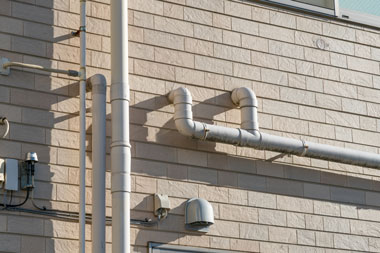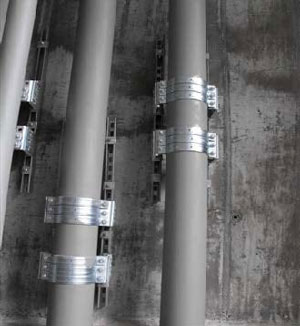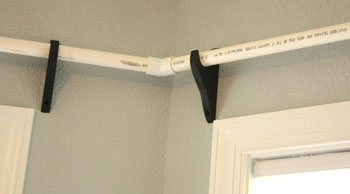It’s essential to install PVC pipe in an evasive manner so that it doesn’t become an obstacle in your way. Instead of securing a plastic pipe to a wall, what other way can you think? Basically, none.
So, how to secure PVC pipe to wall? Well, it depends on how you want to secure the PVC fittings. Generally, if you want to install pipes vertically, you have to do a lot of drilling. But for Horizontally pipe installation, simply mark the wall studs and place conduit straps.
Once everything’s clear, installing a plastic pipe on a wall is not a big deal. Here, we keep no stone unturned on installing a PVC fitting to a wall.
What Do You Use To Attach Pipe To Wall?

There are a lot of modern devices available for attaching pipe to walls. Each of these devices has its own makeup for different use cases. The most popular instruments to secure plastic pipelines include:
Riser Clamps or Conduit Straps: If you are attaching the piping system vertically and it’s penetrating the floor, use riser clamps to secure them. Once you secure riser clamps over the pipe, the huge flanges of the clamps distribute the load on the floor around the opening. As a result, the pipe won’t slide down after attaching it to the wall.
Split Ring Hanger: This device can support vertical and horizontal pipe runs such as solid wall sewer pipes. It’s a small device measuring around ⅜-inches to 4-inches. There’s zero clearance on the wall once you secure a PVC pipe with split rings. But you can only attach small pipes with it.
Tools And Materials Required To Secure Pvc Pipe To Wall
You don’t require any special or power tool to secure PVC pipe to a wall. Just the following will do:
Materials We Need
Usually, we don’t need a lot of materials to install a PVC pipe on the wall. But it’s safe to keep them as you need to cover up for the wall damages or leakage.
Glue (Temporary Solution): You can secure a plastic pipe with glue for a temporary solution. But it works.
Cement: Instead of glue, you can use cement to cover the PVC joints as an adhesive. This way, the connection stays leakproof.
Plumbers Putty: For the water pipeline, it’s always a good idea to use plumber putty to secure the joints.
Tools you need
You must gather the following tools to start the process:
- Handsaw or Recip Saw
- Tape Measure
- Drill Machine
- Hammer
- 1 ½ Screw (For Vertical Pipe Installation)
- 3-inch Screw (For Horizontal Pipe Installation)
- Wall anchor
- Screwdriver
How to Secure Pvc Pipe to Wall? – Three Different Methods?
There are a lot of ways you can secure a PVC pipe to brick wall. But most people follow some common methods to produce better results. And we are covering the three simple methods you can follow to attach a pipe to a wall.
Method 1: Securing Pipes Vertically

Using this method you can vertically adjust the pipe. Let’s dive into the step-by-step procedures.
Step 1: Marking the Pipes
First, you have to create perfect holes for securing PVC pipes to a wall. Get your markers and measurement tape ready. Place a marker line on each 24-inch of plastic pipe.
After marking the pipe, we need to mark the spot where you can drill a hole. Take it easy, and don’t rush.
Taking multiple measurements before creating the mark is a good idea. Especially, DIYers make mistakes while marking. As a result, the holes turn out badly.
Step 3: Drill the Holes
To drill a hole through the markings, you can use a standard roll-rolled or HSS metal drill. We don’t need to create a large hole to attach our PVC pipe. Just a good gap to insert the wall anchor.
The process is quite simple. Hold your drill against the mark on the wall. Press the trigger gently to create the starting point. This way, you can check if the drilling point is right or not.
Slowly start to drill through the starting point and gradually increase the pressure. This way, there won’t be any dust or particles coming out and causing problems for you.
Note: While drilling, try to keep the drill straight. Also, keep a firm grip over your machine.
Step 4: Insert the Wall Anchors
After creating the holes, start entering the wall anchors. To do that, you need to use a small hammer. Gently tap the wall anchors to insert them in the hole.
Step 5: Secure PVC Pipe and Fittings
It’s time to secure the PVC pipe to brick wall. Then, place PVC riser clamps and set the clamp holes along the drilled holes.
If you are going DIY, it’s better to ask someone to keep the pipe steady. This way, you get better control at tightening the screws.
There’s no need to flex your muscles when tightening the screws. Instead, try to secure the pipe to the wall. Once you secure all the clamps, try to tighten them again.
Note: If you are dealing with sewer pipes, use split ring hangers.
Step 6: Cover the gaps
After all that drilling an installation, there are bound to be missing chunks and large holes. Cover them using cement or plumbers putty (for water supply lines)
Note: You have to check whether the screws are secured perfectly or not. Most of the time, the drilled holes are not properly drilled. If that’s the case, use a larger wall anchor.
Method 2: Securing Pipes Horizontally

You have to place a PVC pipe to install it horizontally firmly. In order to do so, follow these instructions.
Step 1: Mark the Wall Stud
When you install the PVC pipe horizontally, it’s a good idea to install it over the studs. Now, the process is similar to the first one we discussed.
In this case, you need to place markings on the wall studs. You need to adjust the length of the pipes depending on the stud.
Step 2: Attaching Conduit Straps
After marking the wall studs, attach just one riser clamp on every marking. Most wall studs are made of wood. So, it shouldn’t be a huge problem to drill through.
Step 3: Securing the Riser Clamps
You need to secure the pipe with 3-inch screws. Generally, 3-inch screws can penetrate deep enough and keep the pipes stable. Once you have secured all the riser clamps, you are complete.
Related Question: Can PVC Pipe Be Buried In Concrete?
Tips For Securing PVC Pipe To Wall
Are you thinking of going DIY? It’s not a bad idea. However, most DIYers make simple mistakes while securing PVC pipes to a wall. In most cases, they either damage the wall or damage the pipes.
That’s why always try to follow these simple things if you’re doing it on your own:
Always Keep the Right Tools
Ever thought about why plumbers make it look so easy? It’s because they always keep the right tools with them. That’s why you have to keep the right tools too.
Well, you don’t need to go for every professional tool. Just try to gather the tools we discussed here.
Keep Spare Parts
Even professionals make mistakes. So, try to keep spare parts for the pipe, screws, and other materials. This way, you don’t have to waste a lot of your time.
Avoid Over Tightening the Screws
Overtightening connection screws may seem a good idea to you. In truth, it’s bad for the walls. So, don’t use too much strength on the screws. Instead, evenly distribute the connection.
Wrapping Up
PVC pipes are ridiculously versatile. So, you can use them for just about any line. The best move is to attach the PVC pipe to a wall. So, how to secure PVC pipe to wall?
It’s easy when you gather the right tools and materials. If you can gather the right tools, attaching a PVC pipe is no big issue at all.